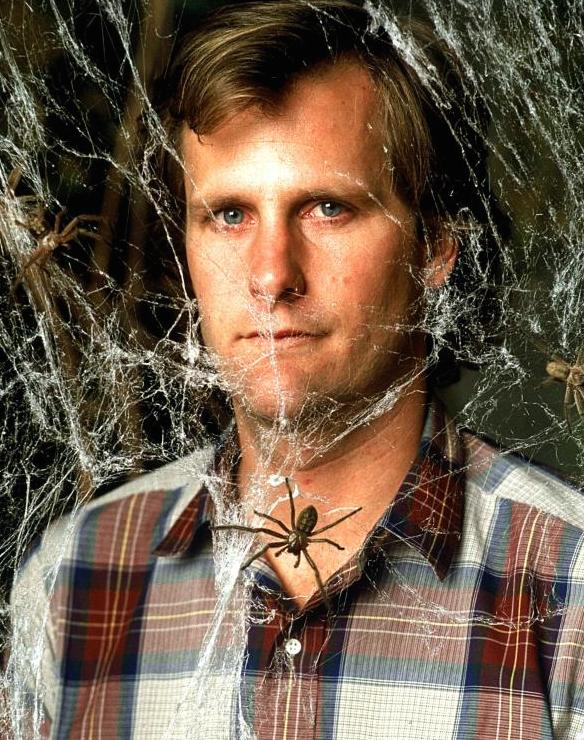Sunday, July 22, 1990.
ARACHNOPHOBIA. Written by Don Jakoby and Wesley Strick. Music by Trevor Jones. Co-executive produced and directed by Frank Marshall. Running time: 110 minutes. Mature entertainment with the B.C. Classifier’s warning: some violent scenes and coarse language.
ROSS JENNINGS (JEFF DANIELS) expects a new life. A Yale-trained general practitioner, he's moved his family from San Francisco to rural Canaima, California, in search of the simple joys of country doctoring.
Jennings is in for a big disappointment. Since their first meeting, old Doc Sam Metcalf (Henry Jones) has changed his mind about retiring. Sorry about that, son.
Across town, Chris Collins (Brian McNamara) expects an afternoon out of the laboratory. A research assistant to entomological superstar Dr. James Atherton (Julian Sands), Collins is dispatched to Canaima to explain to the locals that people rarely die from spider bites.
Collins is in for a big surprise. Young doctor Jennings has indeed found a new and nasty justification for his own acute Arachnophobia — fear of spiders.
I expected a new and exciting vision. Longtime Steven Spielberg associate Frank Marshall's summer comedy shock feature was designed to launch not only a directorial career but a new production entity within the Walt Disney Company.
Arachnophobia is the first film from Hollywood Pictures which, along with Touchstone Pictures, is supposed to reach beyond Disney's traditional "family" audience. Its production partner here is Amblin Entertainment, the company that Spielberg founded together with Marshall and Kathleen Kennedy.
No film industry rookie, Marshall has been involved in the business end of picture-making since 1967. He's been with Spielberg since Raiders of the Lost Ark (1981), and has co-produced many of the most successful films of the 1980s.
Until now, though, his directing experience has been limited to second unit work on the Indiana Jones features and some of "The Making of . . . " television documentaries. Since other Spielberg proteges — specifically Joe (Gremlins) Dante and Robert (Back to the Future) Zemeckis — have proven to be dynamic creative forces, I hoped for much.
Unfortunately, Arachnophobia introduces us to a directorial George Bush. His great resumé notwithstanding, Marshall offers us an empty suit of a movie, a disappointingly bland mechanical exercise in by-the-book filmmaking.
Technically, his film is first-rate. The special effects — including a big, bad Venezuelan arachnid designed by Chris (The Fly; The Fly II) Walas — the cinematography and Trevor Jones's musical score are all A-budget efforts.
The screenplay, though, is borrowed B-fare. Writers Don Jakoby and Wesley Strick probably hope that no one will recall 1977's Kingdom of the Spiders, a better-built tale of creepy-crawlies from which they've appropriated nearly everything, including its girl-in-the-shower scene.
Echoing Spielberg's Jaws, Arachnophobia features a trio of spider hunters. Jennings, the fear-afflicted newcomer, joins with young scientist Collins and Delbert McClintock (John Goodman), the "colourful" professional exterminator from the Bugs-B-Gone Company, to deal with the menace.
The results on screen are surprisingly tepid. Marshall's indifferent direction does little to generate atmosphere, sympathy for his characters or honest laughter to relieve the less-than-terrific tension.
The above is a restored version of a Province review by Michael Walsh originally published in 1990. For additional information on this archived material, please visit my FAQ.
Afterword: I must thank my son-in-law, a scientist by trade and a biologist by specialty, for introducing me to the the Legend of the Christmas Spider. Wikipedia offers the following synopsis of the tale:
“A poor but hardworking widow once lived in a small hut with her children. One summer day, a pine cone fell on the earthen floor of the hut and took root. The widow's children cared for the tree, excited at the prospect of having a Christmas tree by winter. The tree grew, but when Christmas Eve arrived, they could not afford to decorate it. The children sadly went to bed and fell asleep. Early the next morning, they woke up and saw the tree covered with cobwebs. When they opened the windows, the first rays of sunlight touched the webs and turned them into gold and silver. The widow and her children were overjoyed. From then on, they never lived in poverty again.”
The story was first told in the 19th century, following the introduction of the yalynka (Christmas tree) into Ukrainian yuletide celebrations. It combines the ancient respect for the pavuk (spider) — a symbol of good luck in Slavic culture — with the relatively new custom of decorating trees for Christmas. And, as I discovered, there is a cinematic Canadian connection to be found. In 1974, at the beginning of his career, director George Mendeluk adapted Ukrainian author Mykhailo Kotsiubynsky’s short story Yalynka as a short film called The Christmas Tree.
In the above review, I was not kind to producer Frank Marshall’s feature directing debut. Truth to tell, his enduring legacy will be as the producer of such hit franchises as the Indiana Jones, Back to the Future, and Jason Bourne pictures. As it turned out, his Arachnophobia was a boxoffice success, and he went on to direct another three features, two of them shot in British Columbia. Alive, his 1993 survival drama, features location work on Delphine glacier and in the Bugaboo Mountains to tell its story of Uruguayan rugby teammates reduced to cannibalism when their plane crashes in the Andes. Marshall returned to Vancouver, Smithers and Stewart for Eight Below, his 2006 remake of the Japanese movie Antarctica (1983), the story of explorers lost on the South Polar continent. In between, he travelled to more equatorial climes for his adaptation of Michael Crichton’s jungle adventure, Congo (1996).
